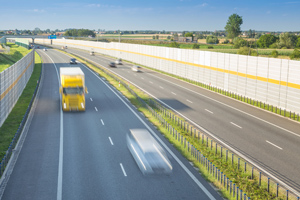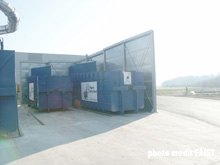A noise barrier wall is a construction that makes it possible to solve many noise pollution problems, as long as it is a question of protecting specified locations for which the diffraction effect, which is the basis of the effectiveness of such a device, is sufficient:
- with respect to the considered frequency
- taking into account the dimensional parameters characterizing the respective positions of the noise source (S) and of the receiver (R) e.g. distance to the noise barrier wall, difference in the path of the sound waves between S and R on the one hand directly (depending on the SR segment ), and on the other hand by considering the limit L which constitutes the considered edge of the noise barrier (according to the double segment SLR).
Depending on the dimensions of the noise barrier wall, the diffraction effect may concern:
- the upper edge (most of the time); the difference in the path of the sound waves is then based on variations in altitude and the performance - all other things being equal - increases with the height of the noise barrier wall
- one or two vertical edges (in the case of structures of limited length); the difference in the path of the sound waves is then based on lengths parallel to the ground
The overall acoustic performance of a noise barrier wall, i.e. the reduction in noise pollution (all the better as - all things being equal - the noise source and the receiver are close to each face) must therefore be evaluated by considering the combination noise levels resulting from the propagation of acoustic waves along the construction bypass paths (often three in number: one above and the other two opposite the vertical edges), and taking into account - where applicable - the presence of sound-reflecting surfaces, a fortiori when they are large, e.g. building facades on the one hand near the noise source, and on the other hand near the receiver.
It is preferable that a noise barrier wall itself has good sound absorption characteristics to limit the amplification of noise levels in relation to the reflection of sound waves on its surfaces.
And, of course, there is no good noise barrier wall that does not have a sound transmission loss that sufficiently opposes the transmission of sound through the obstacle to sound propagation that it must constitute e.g. by the means of its mass density.
ITS markets noise barriers to avoid noise pollution from industrial sites or transport infrastructures.
|
|

Noise barrier wall for transport infrastructure |
With regard to industrial sites, the aim is to keep within specified limits the sound emergence, i.e. the difference between the equivalent continuous pressure levels A-weighted of ambient noise (industrial site in operation) and of residual noise (in the absence of noise generated by the industrial site, but measured over the period of operation of the industrial site).
The main applications are therefore related to limiting the propagation of noise emitted by process equipment (of all kinds) installed outdoors (including chillers facilities), by transformation activities not housed in buildings e.g. wood or scrap yards, quarries, and also by hardware related to dust removal and waste recycling (including when involving loading and unloading of skips).
Sizing on a case-by-case basis allows the definition of the best compromise between acoustic performance, i.e. reduction in noise pollution and construction price in all contexts.
| Metallic acoustic door set |
| Metallic acoustic insulation panel with 1 absorbing face |
| Metallic acoustic insulation panel with 2 absorbing faces |
| Metallic acoustic insulation panel without any absorbing face |
| Metallic acoustic window set |
| Ventilation silencer |
|
Sorry, no dedicated brochure downloadable presently (however: available equipment) |
 Noise barrier wall for industrial site
Noise barrier wall for industrial site